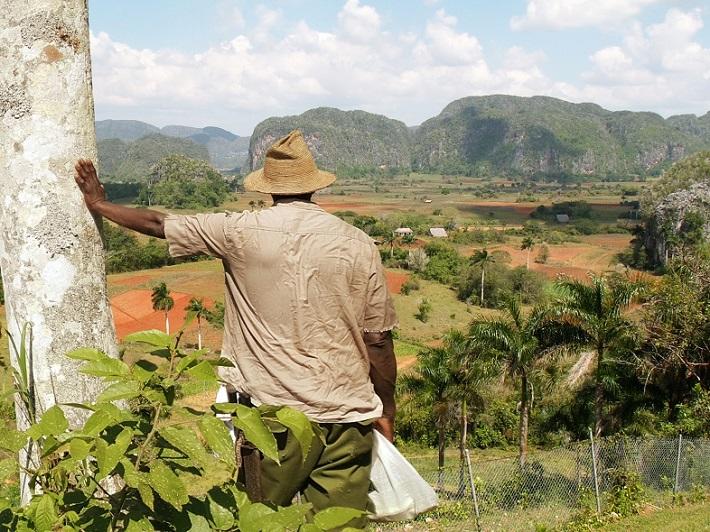New Index outlines agrobiodiversity’s role in food system sustainability

The Agrobiodiversity Index is an innovative tool to calculate how well countries are conserving and using their agricultural biodiversity. The first Index Report includes a 10-country analysis offering practical recommendations to improve the use of agrobiodiversity in diets, markets and production.
ROME, ITALY – The first of its kind, a newly launched index calculates how well countries are conserving and using their agricultural biodiversity to improve diets, markets and production, and achieve sustainable and resilient food systems.
Compiled by Bioversity International, the Agrobiodiversity Index equips food system actors, such as governments, companies and investors, with the data needed to assess and respond to six risks that low agrobiodiversity poses to food and agriculture, namely malnutrition, poverty, climate change and variability, land degradation, pests and diseases, and biodiversity loss.
To do so, it brings together and compares data on agrobiodiversity present in markets and diets, agricultural production systems and genetic resource conservation. The first report includes analysis of ten countries: Australia, China, Ethiopia, India, Italy, Kenya, Nigeria, Peru, South Africa and the United States.
For each country, the Index measures both status, i.e. how much agrobiodiversity currently exists, and progress, i.e. the country’s commitments and actions to improve the use and conservation of agrobiodiversity across diets, production and genetic resources.

"The way food is produced and consumed today is hurting both people and the planet," said Juan Lucas Restrepo, Director General of Bioversity International. "Food systems must be re-conceived to prioritize more diverse and nutritious foods by mainstreaming biodiversity. Doing so also helps mitigate the risk of extinction of one million of the eight million estimated species on the planet this century."
Acording to the Index Report, all countries fared better in their present status than in their intended progress in managing their biodiversity resources, suggesting the need to increase efforts for sustainable use and conservation of this wealth.
Italy, Peru and Australia were the top three countries in terms of current status score. India, Kenya and South Africa instead performed best on the progress score, by making explicit commitments and already putting in place actions to sustainably use and conserve agrobiodiversity.
In terms of markets and consumption for healthy diets, Australia and Italy scored highest, while Ethiopia and India scored lowest. However, the latter pair’s progress score for healthy diets is higher, indicating the presence of commitments and actions to increase agrobiodiversity in the future. Kenya has the highest progress score for agrobiodiversity in healthy diets, having made specific commitments and put in place programmes to promote food diversity for improved nutrition.
In terms of sustainable agricultural production systems, China and Peru scored highest. This is mainly explained by the presence of rich species diversity per land unit in China, and strong integration of natural vegetation in agricultural land in Peru. The lowest scores were found in Australia and the United States: these countries have large areas dedicated to agriculture where both species diversity and natural vegetation in agricultural landscapes are low and can be improved.

India and Kenya showed the highest progress score in sustainable production, having put in place actions and made commitments to improve the use of agrobiodiversity for sustainable production. Finally, agrobiodiversity in genetic resource management is generally high across countries – most of them have considerable numbers of plant accessions conserved ex situ.
The Agrobiodiversity Index aims to assess performance yearly and help countries track their progress; scores can change as countries take actions to better integrate agrobiodiversity and as the methodology and databases of the Index continue to improve.
"We are inviting feedback to help us improve the next round of measurements so we ensure the information generated is useful for countries to find and validate their pathways towards sustainable and resilient food systems," explained Restrepo. "We hope that the insights generated through the Agrobiodiversity Index will help countries identify their strengths and areas for improvement so as to come up with tailored solutions to improve diets, production and genetic resource conservation, based on agrobiodiversity. Also we expect sharing these results to promote collaboration between countries," he added.
Agricultural biodiversity, or agrobiodiversity, is a subset of biodiversity which includes the diversity of crops and their wild relatives, trees, animals, microbes and other species that contribute to agricultural production. More than 6,000 species have been cultivated for food, yet fewer than 200 make major contributions to food security, globally, regionally or nationally, and only 9 account for 66% of total crop production.
"We are essentially running uphill at the moment,” said Restrepo. “Agriculture has to choose if it will be part of the problem exacerbating climate change and land degradation, or part of the solution."
Making the most of the wealth of plants, animals and microorganisms used for food and agriculture can boost productivity and nutrition quality, increase soil and water quality, and reduce the need for fertilizers and pesticides. It also makes farmers' livelihoods more resilient, reducing yield losses due to climate change and pest damage.

"Increasing biodiversity in our food systems gives farmers more options to deal with risks of crop failure, declining soil fertility or increasingly variable weather," said Restrepo. "Boosting agrobiodiversity in food systems from production to consumption is a way to connect the dots in the food landscape. A more agrobiodiverse system could also help millions of farmers to escape the poverty trap they have fallen into as they have adopted monoculture and left behind more biodiverse and rich systems."
Broadening the types of cultivated plants is also good for the environment, increasing the abundance of pollinators and beneficial soil organisms, and reducing the risk of pest and disease epidemics. Tens of thousands of alternatives, and their crop wild relatives, exist and exhibit traits that enable them to grow in difficult environments, produce high nutrient content and increase yields.
A widespread problem is that countries often see agriculture, the environment, nutrition and health as disconnected issues. As a consequence, policies sometimes pull in different directions. Some countries import a wide diversity of food but neglect local food diversity that could underpin healthy agricultural systems, while at the same time support in situ conservation of unique species and varieties. In other countries, farmers still manage high levels of agrobiodiversity on their farms, but sometimes policies do not encourage them to do so undermining their capacity to benefit from it and their desire to maintain it in the long term.
To provide a context and stimulate thinking around the Agrobiodiversity Index, the report also compiled a series of thought pieces in sustainable diets, production, and conservation to provide diverse short perspective on how agrobiodiversity contributes to facing risks and building resilience in food systems. These range from the role of policies and finance to spur appropriate private sector engagement in food systems, to the relationship between diversity in our guts and in our production systems, to the role of women farmers in Ethiopia as knowledge holders and innovators of seeds.
